
Each button is completely hand crafted.
Each creation takes shape in the different phases, typical of ceramic production. The tale invented to tell and present the buttons traces back to the creation process.
1. I was born from a splinter of clay
The main matter of the creations is clay. Based on the techniques utilized and on the desired effects we use low temperature common Italian clays like red clay and earthenware or more precious clays like gres and porcelain which are part of the history of ceramic in other countries.
2. Millions of years were needed to create clay
Clay has its origins in the evolution of the Earth from transformation of granite. A piece of clay, therefore, carries with itself geological history of the Earth and of a specific land.
3. Knowledge
Innate in each button is a path of research and care of the details but also of creation and experimentation in a continuous evolution that allows to differentiate the artifacts that make up the whole series of buttons.
4. And care to transform it
The buttons are shaped using mainly the slab technique. The phyllo dough of clay is cut by hand or on regular shapes and the buttons are moulded eventually imprinting weaves, too.
5. Air made me dry
The moulded handicraft are left to dry. The water that made clay easy to mould dries and the creations become fragile like little splinters of dry earth.
6. Water refined me
The care of details requires some finishing touch of the dry handicrafts. The creations are finished with spatulas and with a wet sponge to smooth out the surfaces removing the imperfections of the moulding.
7. Colours dressed me
Dry buttons can be decorated with coloured clays, with hunchbacks and might be possibly engraved. Or they can be baked in the oven a first time and then glazed or decorated with pigments or with metallic oxides to make them crystalline.
8. Fire transformed me in ceramic
Fire transform the dry handicraft in terracotta during the first baking. In the following baking, fire with its power transforms the decoration in the glazed blanket of the surfaces.
Now you tell me if I’m just a button!
it’s moulded with different techniques
the handiwork are created with different techniques taken from traditional ceramic art and from current research.
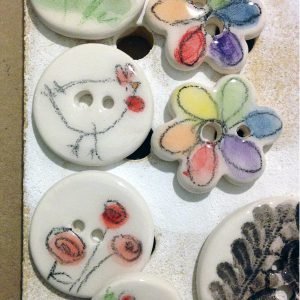 Surfaces are paint brushed with pigments or metallic oxides and covered by a glassy layer given by the crystalline.
Surfaces are paint brushed with pigments or metallic oxides and covered by a glassy layer given by the crystalline.
The use of crayons focuses attention on the technique and gives an outline to the images which seem coming out of a drawing.
The chosen materials are non-toxic and lead free.
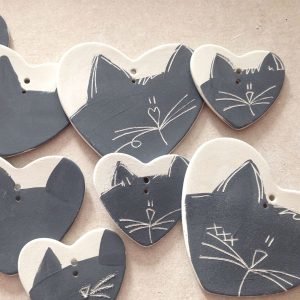 The clay handicrafts in ‘leather hardness’ can be decorated with coloured slips, with hunchbacks and might be possibly engraved.
The clay handicrafts in ‘leather hardness’ can be decorated with coloured slips, with hunchbacks and might be possibly engraved.
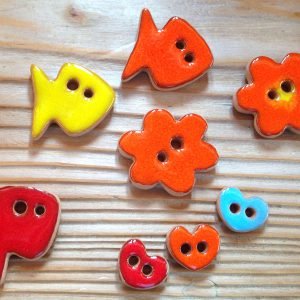 Glaze decorates surfaces covering them with a glassy layering. You play with the brightness of colours or with contrast between them.
Glaze decorates surfaces covering them with a glassy layering. You play with the brightness of colours or with contrast between them.
Baking temperatures range between 940 °C and 1000 °C degrees (1740 ºF – 1830 ºF).
 High temperature, i.e. baking of the handicrafts at over 1200 °C degrees (2200 Fº), makes fascinating the use of glazing and enriches its potential. In particular low temperature clays like majolica and earthenware, but also wood ash might be used as a base to create glazing with silky effects.
High temperature, i.e. baking of the handicrafts at over 1200 °C degrees (2200 Fº), makes fascinating the use of glazing and enriches its potential. In particular low temperature clays like majolica and earthenware, but also wood ash might be used as a base to create glazing with silky effects.
 Raku originates from an ancient Japanese technique use to create bowls for the tea ceremony. In the Western countries the technique has been modified, but we are still left with the charm and the surprise of how fire and smoke will modify the design on the surfaces.
Raku originates from an ancient Japanese technique use to create bowls for the tea ceremony. In the Western countries the technique has been modified, but we are still left with the charm and the surprise of how fire and smoke will modify the design on the surfaces.
In the Naked Raku version the colour leaves room to black and white and to the silky surfaces obtained thanks to the use of sealed earth.
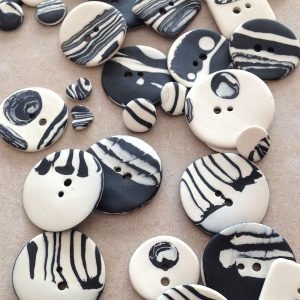 Nerikomi is the name of an ancient technique developed in China and Japan to put together in one single piece different tiles or layers of coloured porcelain. Through the centuries this technique has been recaptured and developed to create different visual effects in the final handicraft. In Italy it’s used also with low temperature clays.
Nerikomi is the name of an ancient technique developed in China and Japan to put together in one single piece different tiles or layers of coloured porcelain. Through the centuries this technique has been recaptured and developed to create different visual effects in the final handicraft. In Italy it’s used also with low temperature clays.
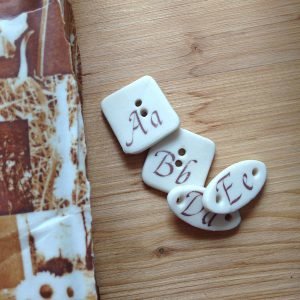 The rust colour holds in the porcelain fragments of memories and images.
The rust colour holds in the porcelain fragments of memories and images.
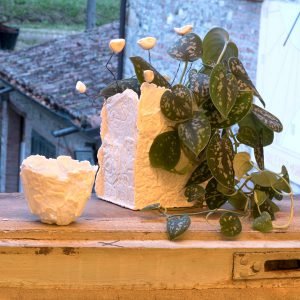 A small percentage of paper mixed to porcelain permits to obtain a dough which opens up new possibilities of moulding thanks to cellulose. You can create handicrafts especially thin and light and you can play in the different shapes composition.
A small percentage of paper mixed to porcelain permits to obtain a dough which opens up new possibilities of moulding thanks to cellulose. You can create handicrafts especially thin and light and you can play in the different shapes composition.
it’s outcome of research and experimentation

Appunti sull’origine delle argille di Giancarlo Scapin

